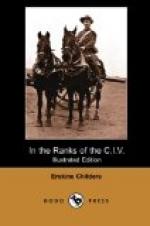“All the afternoon the same desolation, like pictures one sees of the moon’s surface. About six, water and feed at Beaufort West, and horses led out, trucks mucked out, and tea served out.
“The night was very cold; in fact, the climate is quite different on these high table-lands. I woke up about six, looked out, and saw, just opposite, the legend DE AAR, which for the first time seemed to connect us with the war. We stopped a moment, and then moved on through lines of tents, loaded waggons, mountains of ammunition, etc. Then I saw a strange sight, in the shape of ice on puddles and white hoarfrost. Soon out on the broad, brown veldt, far-distant hills showing finely cut in the exquisitely clear air. Such an atmosphere I have never seen for purity. The sun was rising into a cloudless sky from behind a kopje. The flat-topped kopje is now the regular feature. They are just like miniature Table-mountains, and it is easy to see how hard to capture they must be. Water, feed, and breakfast at a tiny roadside place, with the inevitable couple of tents and khaki men. We were at whist when we steamed up to a big, busy camp-station, the Red Cross flying over a dozen big marquee tents, and a couple of hundred sorry-looking remounts (by the look of them) picketed near. This was Naauwport. We stopped alongside a Red Cross train full of white, unshaven faces—enterics and wounded going back to the base. They were cheerful enough, and we shouted inquiries about one another. They were unanimous in saying we were too late, which was very depressing news, but I don’t suppose they knew much about it. We washed ourselves in big buckets here. As we were steaming out I saw a long unfamiliar sight, in the shape of a wholesome, sunburnt English girl, dressed in short-skirted blue serge, stepping out as only an English girl can. She was steering for the Red Cross over the tents, and, I daresay, was nursing there. Off again, over the same country, but looking more inhabited; passed several ostrich farms, with groups of the big, graceful birds walking delicately about; also some herds of cattle, and a distant farm or two, white against the blue hill-shadows. Soon came the first visible signs of war—graves, and long lines of trenches here and there. At a stop at a shanty (can’t call it a station) a man described a fight for a kopje just by the railway. Coleskop was in view, a tall, flat-topped mountain, and later we steamed into the oft-taken and retaken Colesberg Junction, and were shown the hill where the Suffolks were cut up. All was now barren veldt again, and the strangeness of the whole thing struck me curiously. Why should men be fighting here? There seemed to be nothing to fight for, and nothing behind to get to when you had fought.
“May 22.—Tuesday.—As I write we are standing just outside Bloemfontein; cold, sunny morning; the Kaffir quarter just on our right, a hideous collection of mud houses with tin roofs; camps and stores on the left; boundless breadth of veldt beyond; the town in front under a long, low kopje, a quiet, pretty little place.




